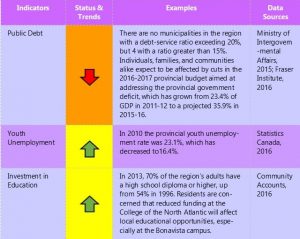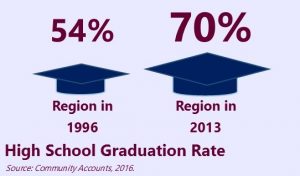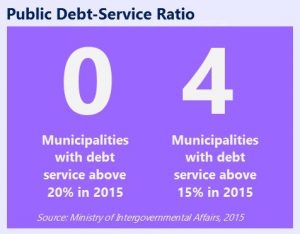Why is This Important?

Jenny Donahue-Keats, a recent graduate of the CNA Bonavista campus’ culinary program. Photo credit: The Packet.
Ensuring sustainable regional development requires taking a long-term view to how we make decisions about our communities and the region overall. We must consider how the decisions we make will affect the next generation, while improving opportunities for our children. In a time of fiscal uncertainty and limited resources, it is more important than ever to reduce the burden of debt we leave for future generations to pay. We must also support public education by strengthening existing primary, secondary, and post-secondary educational institutions in the region. It is also important to make investments in training opportunities that are appropriate for the local economy to ensure that young people in the region will have new opportunities to lead fulfilling lives and careers in their communities for years to come.
Key Indicators and Trends

Perhaps the most important factor that contributes to fulfilling this regional priority is the need for high-quality and affordable educational opportunities for all residents. Investment in education has led to  improvements in the high school graduation rate in the region and high-quality education at the primary, secondary, and post-secondary level. The College of the North Atlantic, with campuses in Clarenville and Bonavista, is a major contributor to training and skills development in the region. These campuses have persevered through budget cuts that have led to the closure of other rural campuses. However, the recent closure of the Bonavista Institute for Cultural Tourism, a one-of-a-kind place-based training program at CNA tailored to the cultural assets of the Bonavista region, was a major loss to the region’s workforce and tourism industry.
improvements in the high school graduation rate in the region and high-quality education at the primary, secondary, and post-secondary level. The College of the North Atlantic, with campuses in Clarenville and Bonavista, is a major contributor to training and skills development in the region. These campuses have persevered through budget cuts that have led to the closure of other rural campuses. However, the recent closure of the Bonavista Institute for Cultural Tourism, a one-of-a-kind place-based training program at CNA tailored to the cultural assets of the Bonavista region, was a major loss to the region’s workforce and tourism industry.

Overall, this indicator ranked as “good” and is improving overall. However, regional leaders must continue to work together to make sure that the College is sustained and recognized for its significant impact on the region, while working to develop new curriculum that aligns with the region’s strategic economic clusters and the training needs of the labour force.

Public debt is another indicator that illustrates how well communities in the region are preparing future generations for success. Municipalities are doing a good job at keeping debt-service ratios low, with only four exceeding 15% in 2015, as shown in the figure to the left. However, the provincial fiscal crisis has affected every community in the province and continues to threaten the financial sustainability and overall well-being of communities throughout the region. Youth unemployment, or the proportion of job-seekers age 18-24, is generally low in the province (regional data are not available for this indicator), and the youth unemployment rate has decreased in recent years.
Overall Status: Good
The overall assessment of this priority shows that the region is doing a good job at providing a promising future for the next generation. The strong educational offerings in the region, from Kindergarten to the College level, provide learners with high-quality education and training opportunities to enter the workforce. Still, concerted effort must be taken to maintain the existing educational infrastructure in the region and continue to develop training programs that fit with the regional economy. One of the major challenges to regional sustainability is the fiscal crisis affecting all of Newfoundland and Labrador, which has threatened core services and assets in the region. The region’s communities and partners in the private and non-profit sector are doing their best to weather the storm and advocate for maintaining core infrastructure to ensure that residents do not lost access to necessary services.
